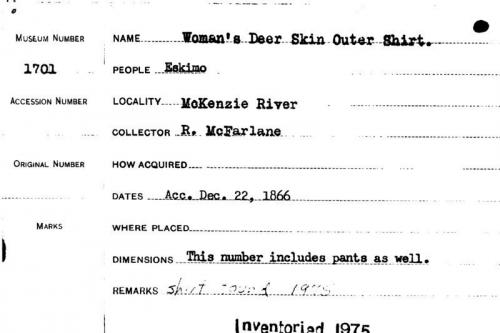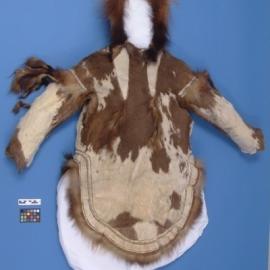In July of 2013, I participated in the Summer Institute of Museum Anthropology at the Smithsonian Institution National Museum of Natural History, in Washington, DC. My plan was to document and establish a visual database of clothing artifacts in the Inuvialuit’s MacFarlane Collection, as a part of my masters thesis project.
I was given unrestricted access to the Smithsonian’s Arctic Collection, including artifacts from Inuvialuit, Yup’ik, Aleutian and Labrador Inuit communities. Amongst these many artifacts, I encountered exquisite traditional Inuit parkas made of animal skin such as caribou, seal and birds.
Aside from my interest in processes of exchange and how these are driven by the dynamics of values, be they economic, cultural or spiritual, I am keen to document the instantiation of these values through design elements in Inuit traditional clothing.
Clothing can be understood as a form of social media that projects the identity of the wearer. During my visit, I observed similarities and differences in the design elements of the garments, which often denoted cultural identity. I analyzed design elements such as the materials used, the production process, production techniques, and ornamental items. By interacting directly with the parkas, I had a subjective and holistic experience of them. I was able to take the measurement of each garment, tracing its pattern and observing the haptic feel of the material.
My visit also encouraged me to consider the way that intangible values are reflected in the material forms of the traditional clothing. For example, I observed how traditional Inuit clothing often embodies the intimate relationship between self, the natural realm (certain fauna and flora) and their corresponding spiritual entities. This sacred connection — respect for nature and the spiritual world — is commonly represented in elements of the parkas.

Top and above: "Women's deer skin outer shirt" (1866) - Inuvialuit parka from the MacFarlane Collection (courtesy of the Inuvialuit Living History website).
While tracing the sewing patterns of a few of these parkas, I noticed that some were made using similar methods as would be employed today. However, others appeared to be created using more traditional practices. For example, an ingenious waterproof sewing technique was used to stitch the bottom-lining of kamiks to its upper part, which prevented water from leaking into the kamik, with no need to rely on the application of a sealant agent.
In our digital media age, issues related to access and control of cultural representation are more complicated than ever. Digital media allows representations of traditional objects and aspects of traditional knowledge, such as production techniques, to circulate widely, often without consent or consideration as to how this distribution might affect the originating communities. My thesis project aims to raise public awareness about this matter through visual ethnography that illustrates the important relationship between material culture, cultural heritage and social identity.
Irine Prastio is an MA candidate at the School of Interactive Arts and Technology at Simon Fraser University and an IPinCH Fellow.







Comments
New word for me!